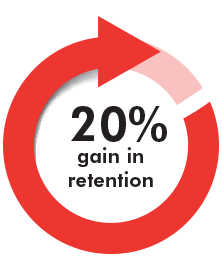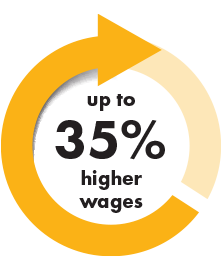From toilet paper to cameras and everything in between—every day seems to bring another media story about market volatility. And now the holidays are approaching, a time of year when warehouse demand is high—and warehouse support is often hard to find.
Those in charge of operations and procurement are already on edge. Here we look at the challenges and how you can meet them heading into the winter holidays.
Challenges Facing Retailers This Holiday Season
Experts predict overall retail sales in the US will grow about 3.5% in 2022. This is despite record inflation and growing economic concerns. But in a waning pandemic, consumer demand for all types of goods and services is growing. That’s good news for retailers, but it also represents potential challenges as they struggle to find enough staff to handle the demand.
There are no remote or hybrid work options when trucks must be unloaded.
The pressure is on as retailers compete for market share while attempting to maintain high customer satisfaction with product quality and delivery -- to store shelves or consumer mailboxes -- quickly and on time.
There are, unfortunately, a number of roadblocks.
Supply Chain Bottlenecks
Supply chains are complex and interconnected. A little glitch in one part of the supply chain can cause a major backlog in another. That puts many warehouses at risk of being unable to meet shipping deadlines and being faced with high overtime costs to make up the backlog.
Xbox CFO Tim Stuart predicts that supply chain issues are likely to continue through the 2022 holiday season. He attributes this, in part, to lockdowns in China. But other experts are noting "a nationwide shortage of truck drivers, a lack of available warehouse space, and rising consumer demand.”
Wages on the Rise, Even as Economy Slows
As workers remain in short supply, wages are rising as companies of all types and sizes vie for talent. Minimum wage of $7.50 an hour? Forget about it. These days, even fast food restaurants like McDonald’s are paying $15/hour without the required minimum wages driving their pay practices.
There’s every indication that those wage pressures will continue as inflation continues, and many predict a recession.
Recruiting and Retaining Warehouse Staff
The unemployment rate in July 2022 was 3.5%. Talent of all kinds is hard to find, making employers scramble to ensure they have adequate people on hand to serve customer needs. Operations managers face the same problems—attracting, retaining, and motivating talent is incredibly tough right now and heading into the 2022 holidays.
As Brian Richmond, President of Eclipse AI, says:
"In the 20+ years we’ve been in business, we’ve never seen staffing shortages in the light industrial sector like we have in 2022. Many Operations Managers have tried a variety of strategies to recruit and retain workers—especially across peak seasons—including incentivized hiring strategies, new labor management software, and more, but what we’ve found is that it really comes down to—when we’re talking about engaging, motivating, and retaining qualified workforces—is finding the right staff for the site and the right managers for those staff members."
What Keeps Workers Around?
Article upon article and report upon report state the same facts, blue-collar workers have increased expectations in what they want out of a job. The top factors motivating these workers are:
- Pay Rates
Pay rates continue to be a big driver of job choices. Consistent pay increases are the second-most-important factor employees consider when choosing a job. - Flexibility
Shift and schedule flexibility, while always important, have risen to even higher levels of importance today—representing one of the top three factors for staying on a job. - Chance for Advancement
The opportunity for advancement is a significant motivator in keeping workers engaged, motivated, and productive. Moving into management ranks can help keep employees engaged while also offering benefits for your company. - Company Culture
Culture matters to employees. Focusing on culture creates a positive working environment. Working together as a team creates experiences that resonate and reward.
A Focus on Profitability vs. Revenue as Markets Tighten
Companies and their operations leaders are increasingly recognizing that the traditional focus on revenue is no longer relevant, especially in the tight markets we now operate in. After all, it doesn’t matter if you make $1 million in revenue if you have $800 thousand—or even $1.2 million—in expenses.
Margin matters. The more companies can do to drive expenses out of their supply chain, the more profit they’ll have.
It’s not a new concept, but it’s receiving renewed focus in a tight economy where costs are rising, capital is declining, and labor costs often reflect a significant portion of any company’s budget.
In this tough market environment, companies are also facing shifting consumer sentiment and new expectations for dealing with suppliers.
The Pandemic Continuing to Drive BOPIS
Consumer shopping patterns have changed significantly during the pandemic. And, as the pandemic continues, those changes also continue—with wide variation based on geography and the ongoing state of concerns about the virus.
One of these trends has been the increase in interest in BOPIS—buy online, pick up in-store. BOPIS demand is projected to continue this 2022 holiday season. Any delays at the dock will prove costly if shipping isn’t on schedule. Workers need to be more efficient than ever before—and more adept at working as a team.
Now is the time to be thinking and planning for these impacts.
Addressing the Challenges
So what can harried operations managers do to be poised for proficiency this holiday season? We’ve identified some best practices that can help you ride out this holiday season if you act on them now.
Get Your Warehouse Workers on Deck Now
Traditionally, many consumers procrastinate and last-minute holiday shopping prevails, however, things are trending a bit different this year. In fact, McKinsey predicts that consumers will start their holiday shopping early to avert any potential problems buying the things they need.
The holidays—and seasonal holiday demand—will be upon you before you know it, especially with consumers indicating that they plan to start their holiday shopping early this year. Take steps now to ensure that you’ll have the warehouse workers you need to ensure trucks can be unloaded efficiently and cost-effectively.
Increase Efficiencies in Your Operations
Operations leaders always seek opportunities to gain efficiencies at every step along the supply chain. Continuous improvement is an evergreen mantra that remains a top focus. Unfortunately, sometimes supply chain operations work at cross purposes, as we’ve seen. For instance, when workers are paid by the hour, they’re actually disincentivized to work more productively.
As Eclipse IA CEO Peter Westermann explains in the article Industrial Athletes for the Modern Supply Chain:
"In the commodity model, warehouse workers are paid hourly. Their goal for work is to be there for eight hours, then go home. The temptation is to be less productive and get more hours, and the warehouse pays more for less work.
To make up for that loss, employers hire additional commodity workers, who are also getting paid more for less work. The impact on the bottom line is the equivalent of driving in the wrong direction, but faster."
Encouraging Productivity Through a Cost Per Unit Model
Instead of a commodity model, a Cost Per Unit (CPU) model employs a team-pay structure that incentivizes workers to meet collective goals and allows them to earn more.
Additional Operational Efficiencies
Other operational efficiencies to consider include:
- Look at your processes for loading, unloading, picking and packing.
Are there opportunities to remove steps, or eliminate waste from these processes? Could the layout of your facility and loading docks be optimized for greater efficiencies? - Analyze your workforce.
Does it make sense to use your own workers, or would it make more sense—from both a cost and productivity standpoint—to outsource? Should your focus be on managing workers—or running the most efficient operations? - Consider ways to streamline last-mile delivery.
For instance, what impacts might a zip sortation site have for your operations?
A Case in Point
The impacts of efforts to increase efficiencies can be striking. For instance, we worked with a major eCommerce company to start up a zip sortation site for last-mile delivery. To ensure a minimum of 400 reliable workers for go-live, we recruited, screened, and made offers to 900 candidates. During the one-month ramp-up period, Eclipse IA hired 30 qualified workers daily for 30 days while maintaining an ongoing waitlist of potential applicants eager to join the team.
This was no simple task, but our efforts went beyond simply having workers on site to ensure these workers were operating at peak production through our unique productivity pay workforce model. The results: these workers processed 1,425,000 packages on average, each month, with 99.8% accuracy. And, this scalable-startup framework can easily be replicated anywhere else in the country.
Manage Holiday Staff With a Strong Partner
Experienced operations managers know that the hardest part of gaining efficiency is people logistics. To improve your management here, address issues such as:
- Do you have the quality and quantity of staff on deck to meet holiday demand?
- How can schedules be flexible to handle peak demand, shifts in demand, or the unexpected--e.g., weather-related travel events?
- How can you get and keep workers engaged and motivated to maintain productivity?
- How can you balance costs and output to maximize ROI?
These are critical issues that fall directly into the laps of operations leaders tasked with finding opportunities to overcome emerging supply chain challenges--and to do it during the busiest time of year for shippers.
Avoid Being Stretched Too Thin
Operations managers are very busy and charged with critical aspects of managing operations to ensure customer needs are met efficiently--and cost-effectively. Their expertise is in logistics and process management--and not, necessarily, people management and motivation.
While people are obviously a critical part of the process, people management often pulls operations leaders away from areas of strategic impact where they are uniquely positioned to provide real value.
The best solution to address supply chain bottlenecks this holiday season is to outsource the most difficult challenge you face every day—finding, onboarding, training, motivating, and retaining top-quality workers who come together as a team to achieve maximum efficiencies. All, while also controlling costs and being able to forecast expenses accurately.
You can take the uncertainty out of the staffing costs equation while, at the same time, ensuring a high level of production. Having a fixed-cost model to handle your warehousing needs this holiday season protects your margins while motivating your people.
Managed service takes away the headaches of managing workers while providing guaranteed results:
- Better source of qualified staff.
- Predictable costs.
- Greater staff engagement and productivity.
- Better output.
- Better chances of meeting customer demands despite supply chain bottlenecks and uncertainty.
How Eclipse IA Relieves Your Burden
We provide incredible Cost Per Unit managed teams that subscribe to strong core principles of teamwork. We focus our wages on performance for:
- Productivity
- Retention
- Fair compensation
- Leadership
- Morale and culture

HIGHER PRODUCTIVITY

20% GAIN IN RETENTION

UP TO 35% HIGHER WAGES
WITH STATIC COSTS

STRONGER LEADERSHIP

BETTER MORALE

STRONGER CULTURE
Cost Per Unit Explained
How does a CPU model work? Each person on our teams are paid the same wage, and as the team becomes more efficient and productive, the pay rate increases while customer costs remain static. The model works because it is in everyone’s best interest to get the entire team to be as productive as possible.
In a traditional hourly payment model, workers are incentivized for the amount of time they put in. When unloading a truck, for instance, the longer it takes the more they’ll be paid.
But when you flip this model and, instead, pay people on a Cost Per Unit basis, or $X for every item or box they unload from a truck, it doesn’t matter if it takes them 10 minutes or 10 hours. The more they unload, the more they make.
That provides a significant benefit—and a big incentive—for them. It also provides a considerable benefit, and peace of mind for our clients.
Under a Cost Per Unit model, you know exactly what it will
cost to have a product unloaded.
Paying for Performance Is Not New - and it Works!
Paying workers based on output is not a new concept. In fact, there are decades of research and reports to support pay-for-performance (PFP) over a pay-for-time model.
According to a study published in the Journal of Applied Behavior Analysis:
"PFP systems produce higher rates of performance and more time on tasks than PFT systems. This finding replicates previous research that has evaluated PFP systems."
Under this type of productivity pay model, teams work together to get the job done as efficiently as possible, so they all optimize their pay. The most seasoned team member is inclined to help coach and assist the less seasoned team members because when one performs well, the entire team is compensated for that high performance. No one is left behind.
Increase pay to your staff by 35%, with no increased labor costs to you!
The cost per unit structure leads to a better team environment, a strong culture, and, consequently, greater retention and less turnover. In fact, at Eclipse IA, we’ve seen a steady 20%+ gain in retention when our clients tie wages to performance. This is a huge benefit for our warehouse clients, but workers also benefit—we’ve seen wage increases of up to 35%, without increased labor costs for our clients.
A model like this is one major driver of the ability to keep adequate workers on board—a big boon during the impending holiday season when talent will be in top demand.
Get Started
You can survive the holidays this year if you manage your headcount, which maximizes productivity, the biggest challenge facing retailers and distributors this holiday season.
This holiday season, pay less—get more—with a warehouse worker model that doesn’t cost, it pays!





